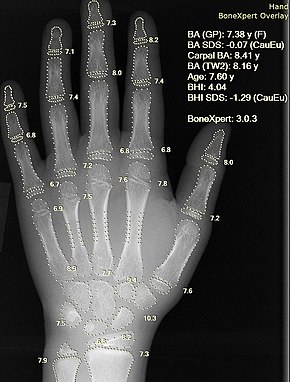
Back تشخيص بمساعدة الحاسوب Arabic Diagnòstics assistits per ordinador Catalan Computerassistierte Detektion German Diagnósticos asistidos por ordenador Spanish تشخیص به کمک کامپیوتر Persian Aide au diagnostic médical French Համակարգչային բժշկական ախտորոշում Armenian Diagnosi automatizzata Italian コンピュータ支援診断 Japanese Computer-aided diagnosis Dutch
This article needs more reliable medical references for verification or relies too heavily on primary sources. (December 2023) |  |
| Computer-aided diagnosis | |
|---|---|
 | |
| Purpose | computer assistance diagnosis of images |
Computer-aided detection (CADe), also called computer-aided diagnosis (CADx), are systems that assist doctors in the interpretation of medical images. Imaging techniques in X-ray, MRI, Endoscopy, and ultrasound diagnostics yield a great deal of information that the radiologist or other medical professional has to analyze and evaluate comprehensively in a short time. CAD systems process digital images or videos for typical appearances and to highlight conspicuous sections, such as possible diseases, in order to offer input to support a decision taken by the professional.
CAD also has potential future applications in digital pathology with the advent of whole-slide imaging and machine learning algorithms. So far its application has been limited to quantifying immunostaining but is also being investigated for the standard H&E stain.[1]
CAD is an interdisciplinary technology combining elements of artificial intelligence and computer vision with radiological and pathology image processing. A typical application is the detection of a tumor. For instance, some hospitals use CAD to support preventive medical check-ups in mammography (diagnosis of breast cancer), the detection of polyps in Colonoscopy, and lung cancer.
Computer-aided detection (CADe) systems are usually confined to marking conspicuous structures and sections. Computer-aided diagnosis (CADx) systems evaluate the conspicuous structures. For example, in mammography CAD highlights microcalcification clusters and hyperdense structures in the soft tissue. This allows the radiologist to draw conclusions about the condition of the pathology. Another application is CADq, which quantifies, e.g., the size of a tumor or the tumor's behavior in contrast medium uptake. Computer-aided simple triage (CAST) is another type of CAD, which performs a fully automatic initial interpretation and triage of studies into some meaningful categories (e.g. negative and positive). CAST is particularly applicable in emergency diagnostic imaging, where a prompt diagnosis of critical, life-threatening condition is required.
Although CAD has been used in clinical environments for over 40 years, CAD usually does not substitute the doctor or other professional, but rather plays a supporting role. The professional (generally a radiologist) is generally responsible for the final interpretation of a medical image.[2] However, the goal of some CAD systems is to detect earliest signs of abnormality in patients that human professionals cannot, as in diabetic retinopathy, architectural distortion in mammograms,[3][4] ground-glass nodules in thoracic CT,[5][6] and non-polypoid (“flat”) lesions in CT colonography.[7]
- ^ "Computer-aided Diagnosis: The Tipping Point for Digital Pathology". Digital Pathology Association. 27 April 2017.
- ^ Oakden-Rayner, Luke (May 2019). "The Rebirth of CAD: How Is Modern AI Different from the CAD We Know?". Radiology: Artificial Intelligence. 1 (3): e180089. doi:10.1148/ryai.2019180089. ISSN 2638-6100. PMC 8017402. PMID 33937793.
- ^ Bird, R. E.; Wallace, T. W.; Yankaskas, B. C. (1992). "Analysis of cancers missed at screening mammography". Radiology. 184 (3): 613–617. doi:10.1148/radiology.184.3.1509041. PMID 1509041.
- ^ Baker, J. A.; Rosen, E. L.; Lo, J. Y.; et al. (2003). "Computer-Aided Detection (CAD) in Screening Mammography: Sensitivity of Commercial CAD Systems for Detecting Architectural Distortion". American Journal of Roentgenology. 181 (4): 1083–1088. doi:10.2214/ajr.181.4.1811083. PMID 14500236.
- ^ Jang, H. J.; Lee, K. S.; Kwon, O. J.; et al. (1996). "Bronchioloalveolar carcinoma: focal area of ground-glass attenuation at thin-section CT as an early sign". Radiology. 199 (2): 485–488. doi:10.1148/radiology.199.2.8668800. PMID 8668800.
- ^ Suzuki, K.; Li, F.; Sone, S.; Doi, K. (2005). "Computer-aided diagnostic scheme for distinction between benign and malignant nodules in thoracic low-dose CT by use of massive training artificial neural network". IEEE Transactions on Medical Imaging. 24 (9): 1138–1150. doi:10.1109/tmi.2005.852048. PMID 16156352. S2CID 2690415.
- ^ Lostumbo, A.; Suzuki, K.; Dachman, A. H. (2010). "Flat lesions in CT colonography". Abdom Imaging. 35 (5): 578–583. doi:10.1007/s00261-009-9562-3. PMID 19633882. S2CID 13487349.
© MMXXIII Rich X Search. We shall prevail. All rights reserved. Rich X Search